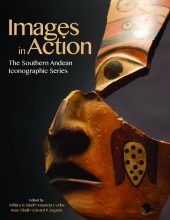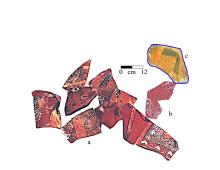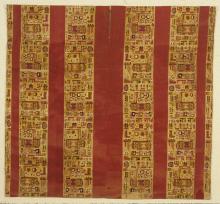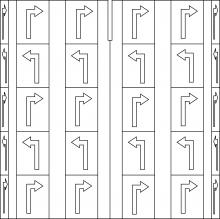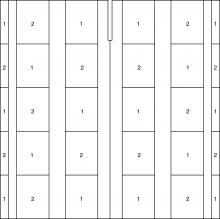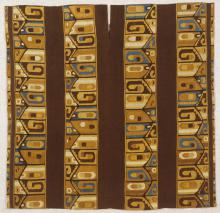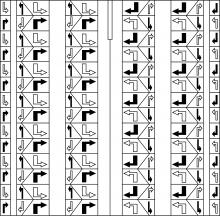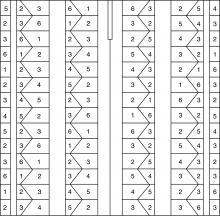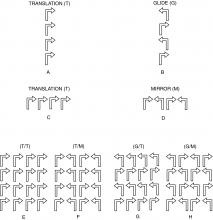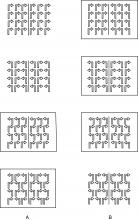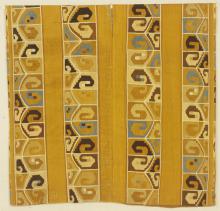Visual database
Partial reconstruction of one Conchopata-style urn from José Ochatoma and Martha Cabrera's 1998 excavations. Assigned to Epoch 2A (AD 825-850). Figures are (a) Agent 110 as full-body warrior holding axe confronting (b) Agent 112, another warrior holding an axe and severed head on chest; (c) profile head of Agent 132. The hue of sherds differs due to camera settings. Courtesy of William H. Isbell (b) and Patricia J. Knobloch (c).
Charting patterns in a figurative tunic from the Middle Horizon. (a) A bipedal figure with a panpipe is repeated on the tunic. The Textile Museum, Washington, DC, 1966.5.2. Museum Purchase.
Charting patterns in a figurative tunic from the Middle Horizon. (b) Symmetry chart showing the alternating orientation of figures in vertical bands.
Charting patterns in a figurative tunic from the Middle Horizon. (c) Color chart showing the checkerboard alternation of two color units in the tunic.
Charting patterns in a geometric tunic from the Middle Horizon. (a) A profile face and a stepped fret alternate on the tunic. The Textile Museum, Washington, DC, 91.343. Acquired by George Hewitt Myers in 1941.
Charting patterns in a geometric tunic from the Middle Horizon. (b) Symmetry chart showing the four orientations of the two icons. Profile faces are shown with black arrows.
Charting patterns in a geometric tunic from the Middle Horizon. (c) Color chart showing a pattern based on six color units that repeat in an eight-part cycle (with some deviation in the lower right).
Deriving the symmetry patterns in figurative tunic panels from vertical and horizontal repetitions. (a, b) Vertical columns: translation (T) and glide (G); (c, d) horizontal rows: translation (T) and mirror (M); (e-h) possible field patterns in tunic panels (vertical repetition is noted first): translation/translation (T/T), translation/mirror (T/M), glide/translation (G/T), and glide/mirror (G/M).
Eight possibilities exist for symmetry patterns on tunic fronts that display figurative imagery. At the center seam, the pattern is continued by translation symmetry (column a) or by mirror symmetry (column b). The patterns that are documented in the sample of known tunics are outlined with boxes.
Geometric tunic with a symmetry pattern based on the repetition of one motif, the stepped fret, in four orientations. The color pattern is based on eight color units that repeat in parallel diagonals (with some deviation in the lower left). The Textile Museum, Washington, DC, 91.301. Acquired by George Hewitt Myers in 1938.
